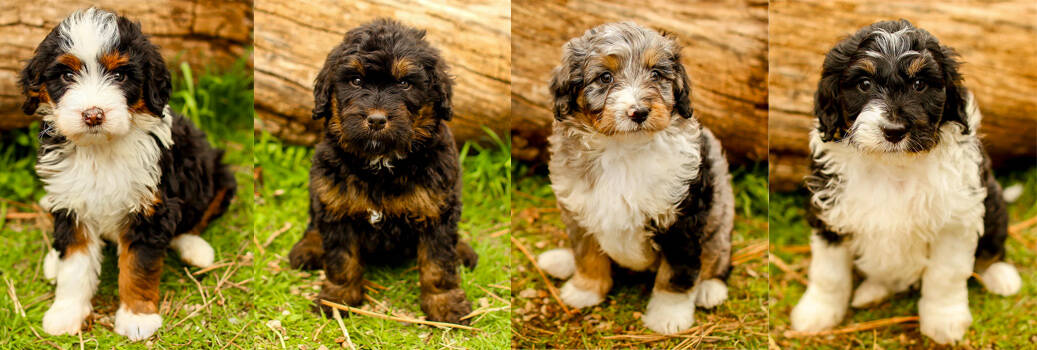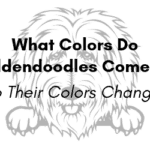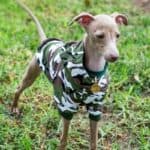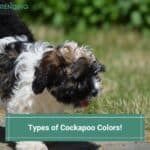
Bernedoodles are growing in popularity, in part because of their friendly temperament and loving nature, but also because of their beautiful low-to-no shed coats. Bred from a Bernese Mountain Dog and a Poodle, it shouldn’t come as a surprise that they have some color variation in their coat. Most of the color variation found in their coats can be attributed to their Poodle genes since they’re found in a variety of different colors. If you’re considering adding a Bernedoodle to your family, one of the considerations you’ll face is what color to get.
What colors do Bernedoodles come in? They come in a variety of different colors, including black, black & brown, black & white, or a tri-color mix of white, black and brown. In addition to different colors, Bernedoodles are also found with various coat patterns including Merle, Sable, Phantom, and Brindle.
Bernese Mountain Dogs don’t come in too many color variations. They’re typically tri-color with a black background and some mixtures of white and brown or rust. Poodles, on the other hand, come in many colors, including white, black, apricot, cream, black and white, silver, brown, silver and blue. Mixing these two dogs not only results in the Bernedoodle but also a dog that may come in any number of colors or patterns.
Getting a Bernedoodle? If you’re in the process of researching Bernedoodles, I highly recommend the book “Bernedoodles: A Head To Tail Guide”. Finding the right Bernedoodle puppy can be confusing and costly. In it, Sherry Rupke, the woman credited with creating the Bernedoodle, shares tons of info from selecting the perfect dog to choosing a quality breeder and more.
Bernedoodle Colors And Patterns
Bernedoodles come in so many different colors, but it’s not even the numerous colors that make this dog so attractive and unique. They also come in various colors and patterns. Choosing a Bernedoodle is almost like choosing fabric in a sewing store – the sky is the limit. Genetics plays a big part in what color a dog may be when they’re born and when they’re adult dogs. It’s not uncommon at all for a puppy to be one color when it’s little and look entirely different as an adult dog.
In the case of the Bernedoodle, genetics really play a big part in the dog’s colors and patterns. In addition to the very basic solid colors often found in Bernedoodles, their color patterns may be determined by generational breeding. F1 Bernedoodles, which are the result of breeding a Bernese Mountain Dog with a Poodle, traditionally come in colors similar to the Bernese Mountain Dog, including:
- Phantom
- Tri-color Phantom
- Tri-color Sable
- Merle Phantom
- Sable & White
- Brindle & White
- Black
- Sable Phantom
- Merle & White
- Black & White
- Tri-Color Merle
An F1 Bernadoodle should not be chocolate, tri-color chocolate, cream, cream and white or chocolate and white. In order for the dogs to be any of these colors, both the sire and the dam must carry these colors, and Bernese Mountain Dogs do not carry chocolate, cream or brown.
F1B Bernedoodles, which are the result of breeding a Bernedoodle with a Poodle, often come in these traditional Bernese color and tri-colors.
- Tri-color Phantom
- Phantom
- Tri-Color Sable
- Sable & White
- Cream & White
- Sable Phantom
- Sable and White
- Chocolate Phantom
- Brindle & White
- Black
- Chocolate
- Black and White
- Tri-Color Merle
- Chocolate & White
- Merle & White
- Merle Phantom
- Cream
The same color patterns found in F1B Bernedoodles can be found in multi-generation Bernedoodles.
What Do Different Color Patterns Mean?
The Bernedoodle’s coat consists of several base colors. Although black is the traditional base color, other base colors can be cream, chocolate or red. Any other variations are usually in the patterns. Here are some common color patterns and descriptions.
- A Phantom colored dog has one main color and tips of a different color. It may have a base coat of black with tan on the chest, legs, cheeks, and eyebrows.
- Phantom tri-color dog has a mixture of black, white and rust. They typically have a black base, some white on the chest, tan legs and no white on the face.
- A brindle colored dog has a coat that’s considered tiger-striped but more subtle than an actual tiger’s coat. They can be solid brindle or mixed with white. Brindles are usually either red-based or blue-based brindles.
- Sable is used to describe the dog’s coat color when the background of any solid color covered with black-tipped hairs. Sable Bernedoodles can have some white mixed in or maybe 100% sable.
- Merle refers more to the pattern of a coat than to the actual color. It’s a combination in a Bernedoodle’s coat. The coat will be a solid color with wither patches, usually red or blue/gray, given the coat a speckled effect. The blue merle, a popular color, is when white and gray designs show up on a black base, giving it a bluish cast.
- Bi-color Bernedoodle coats consist of two colors. It consists of the classic pattern found in the Bernese Mountain Dog but without the rust color on the face and legs.
Which Colors Are The Most Popular?
When choosing a Bernedoodle dog based on colors and patterns, it’s often hard to make a choice because they’re all so beautiful and all so unique in their own way. The tri-color Bernedoodle is the most desired coat, but it’s also the most difficult to produce. Perhaps it’s such a popular color because it’s difficult to achieve. Whatever the reason, Bernedoodle owners seem to always prefer this color. The solid color Bernedoodle is a very popular color choice because they seem to have a stunning appearance.
Which Colors Are Hard To Find?
As stated above, the tri-color Bernedoodle may be the most sought after but is one of the hardest to produce. Aspiring Bernedoodle owners are often put on a long waiting list to get a tri-color Bernedoodle. Other rare colors that can be hard to find are bi-color black and white, and mahogany sable and white. Poodles carry a gene, called a fading gene, which can be passed from the Poodle side of the family down to the puppies. This gene causes the dog’s coat color to fade and lighten as the dog ages.
Related Questions
Do Bernedoodles need to be groomed?
When discussing the Bernedoodle’s coat and grooming requirements, there is good news and bad news. Bernedoodles are similar to Poodles in that they have hair rather than fur, and they shed very little if at all. That is the good news. The bad news is that it needs to be brushed regularly to prevent it from matting. When it mats, it develops little clumps almost like tumbleweed under the overcoat, and this can be a real battle to comb through.
The curlier the coat, the more often it should be brushed. Some Bernedoodle owners brush the dog every day. In addition to brushing the Bernedoodles coat, it should also be clipped every two to three months. The dog can be bathed a few times a year but should not be bathed too often to avoid stripping the coat of its natural oils.
We talk more about the grooming (and bathing) needs of a Bernedoodle in this article.
What does the coat of a Bernedoodle feel like?
Bernedoodles come in one of three different coat types: curly, wavy and straight. The curly and wavy coat has a soft and silky feel to it while the straight coat has a rougher texture, yet it’s also somewhat soft and smooth. The dog’s coat type plays a big part in its grooming requirements and its hypoallergenic qualities. The curlier or wavier the dog’s hair is, the more it will need to be groomed and/or trimmed. However, the curlier the dog’s coat, the less it sheds and the better the dog will be with allergy sufferers.
We talk more about the different coats of the Bernedoodle in this article.
That’s A Wrap!
Color is often the first criteria used when picking out a new dog. Fortunately, the Bernedoodle dog gives you many colors and patterns from which to choose. Whether you’re choosing your Bernedoodle to show or as a family pet, you’ll be able to have the dog of your dreams when you go with this adorable breed, regardless of the color.




